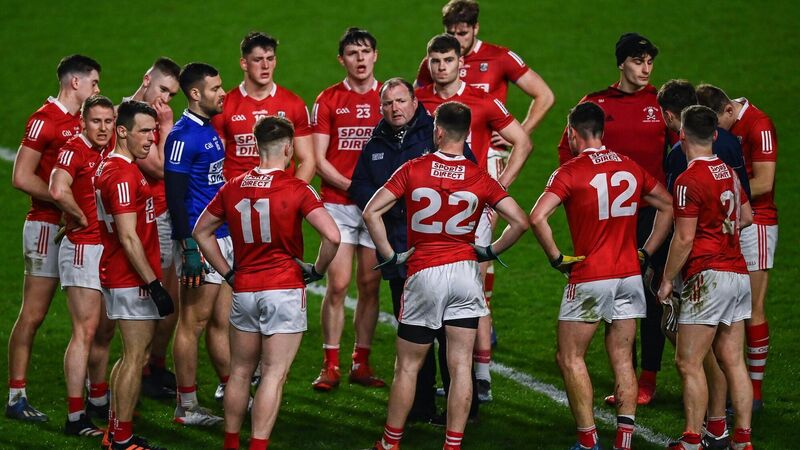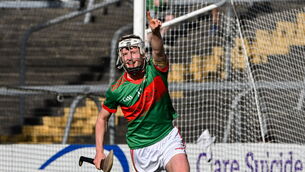Kieran Shannon: Too many safety nets for top sides but Tailteann Cup may offer a real chance to grow

Cork manager Keith Ricken speaking to his players after the Allianz League defeat to Galway at Páirc Ui Chaoimh. The Tailteann Cup could prove to be the kind of place and competition that could allow a side to regroup and grow and win again, says Kieran Shannon.
ND so just like that it’s ushered through by the kind of method and winning margin Putin would be impressed by: a new football championship structure.
After all the airtime and column inches and indeed passion and imagination devoted to such a topic through the years, especially leading up to what was a genuinely special congress last autumn, there was barely a word of resistance or even reportage concerning the Proposal Green that breezed through Congress proper last weekend in Bekan.
At this point we can now say that the whole process was straight from the GAA politicking playbook, the Croke Park mandarins appeasing — and yielding to — key conservative elements while also able to spin the end product as being progressive, or at least progress. The make-up of the original fixtures committee; the anaemic and belated support from the top table for Proposal B; then kicking it to a new committee inherently biased, comprised as it was of all four provincial vice-chairs; labelling their preferred option Proposal Green and its alternative (the superior) Proposal Red; then passing it off to Central Council to rubberstamp for Congress to do the same, as evident by its 94.7% backing.
In early December Kevin O’Donovan, the progressive Cork CEO who would have been more aligned with the red proposal, expressed his wish and eagerness for the ball to be thrown in for a debate on the respective merits of green and red, but in truth that throw-in, that replay following the draw that was special congress, never took place. Instead essentially there was a walkover.
And so next year we will have something of a fudge: the leagues retained in their current format and calendar slot; the provincial championships likewise ran off as they currently are, albeit in an even tighter timeframe; followed by a 16-team (four groups of four) round-robin All-Ireland phase where it will take 24 games to eliminate four counties. The whole year seems like one big slow burner, when Proposal Red would have ensured that things were a lot hotter a lot earlier on in the championship, with only eight of the 16 teams advancing after each playing seven games. Put it this way: if this year’s league was next year’s championship along the lines Proposal Red was advocating, Dublin, with their current formline, would not make the All-Ireland quarter-finals for the first time since 2003. Proposal Green gives them several more safety nets.
One competition though that the authorities may have got right and will likely be a hit right from the off this summer is the Tailteann Cup.
There are still those who have concerns about it. On top of the historical residue of the Tommy Murphy Cup, the news that its final will take place the weekend of the All- Ireland semi-finals rather than the final itself has been perceived as already a diminution of its status and appeal. On last week’s Irish Examiner football podcast, Oisín McConville, after seeing how indifferent the GAA seemed to whether Trench Cup final was completed with or without his Dundalk IT side, expressed his fear that such apathy to second-tier competition could well extend to the
Tailteann Cup.
This column though would be more optimistic. The fact its final is on the same weekend as an All-Ireland semi-final means its climax will be played with likely 60,000-plus in Croke Park, rather than it being played the night before the All-Ireland itself in front of a crowd closer to what you’d get for a Division Three or Four final.
And then just look at the bottom of Division Two as well as all of Division Three and Four.
After three rounds of Division Three, every team has already lost at least one game — but six teams have only lost the one game. Every team has at least picked up one point in their first three games. There is little between top and bottom.
Division Four is similarly tight, with the possible exception of Cavan — and even then they had only four points to spare against Carlow as well as Leitrim. At this juncture only Carlow and Waterford would appear to be out of the promotion picture, and neither would discount themselves from a good run in the Tailteann Cup. Waterford have already drawn to 2020 Munster champions Tipperary. Last weekend they put it up to Leitrim, with their (fly) goalkeeper Ben Kirwan putting on one of the most impressive performances of the weekend by anyone nominally wearing a number one jersey.
In the same game though he was outshone by Keith Beirne who put on a performance that can only be described as McGuiganesque, his 12 points, seven from play, reminiscent of the two-footed exhibition Brian’s father Frank famously put on in the 1984 Ulster final. His five frees were just as impressive, with only one of them reportedly a give-me. Outside of possibly Matt Connor and Maurice Fitzgerald in their pomp, it is hard to recall someone so comfortable kicking long-range frees from either foot but Beirne is such a talent. The Tailteann Cup allows it a stage to shine this summer, possibly even in Croke Park.
Neither team that featured in Dungarvan Sunday would be afraid or undeserving of a shot at Limerick, the side who top Division Three. Just as there is little between the teams in either division, there is little between either division. Anyone — everyone — would fancy themselves making a run in the Tailteann Cup, getting to Croker — and if needs be, facing whoever comes down from Division Two.
As both Éamonn Fitzmaurice and indeed Keith Ricken have pointed out in these pages, it may not necessarily be a disaster for a side such as Cork to be relegated from the second division; the Tailteann Cup could prove to be the kind of place and competition that could allow a side to regroup and grow and win again just like several club sides have found dropping to intermediate proved to be more a launching pad than a pitfall for them. Still, the frisson and stigma that goes with the prospect of relegation makes Division Two of the football league one of the most intriguing of leagues in all the GAA, same as it always has been.
Sadly hurling — or at least its hurling league — is losing out for the lack of such a dynamic. Last year’s league seemed like one big long phony war with it being so close to the championship, but this year’s version feels even phonier and irrelevant with the return of the round-robin provincial championship.
Nothing seems to be at stake; outside the teams themselves who really cares about them — and do they even care about them?
It was always going to be the way: in rightly making the championship better, it has made the league worse,
especially one without relegation. Football has had enough talk about competition structures for a while but hurling might need a new one. Like about whether its top teams need the threat of relegation. Or whether the league should be cross-provincial: that in the league, Munster teams only play non-Munster teams to eliminate the sense of phony battles we seem to have now. Or even more so that instead of a league, everyone just plays everyone in championship, starting from St Patrick’s Day or early April.
There’s a reason why the football is on before the hurling on League Sunday whenever there’s a full round of both codes, just like in April hurling will dominate the live broadcasts ahead of dour provincial football games
outside of Ulster and Galway-Mayo. More is at stake.








